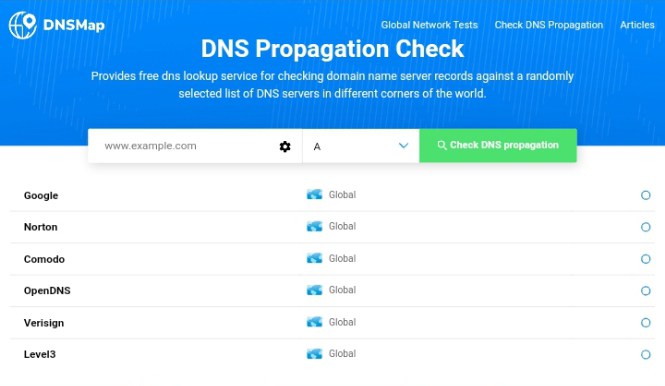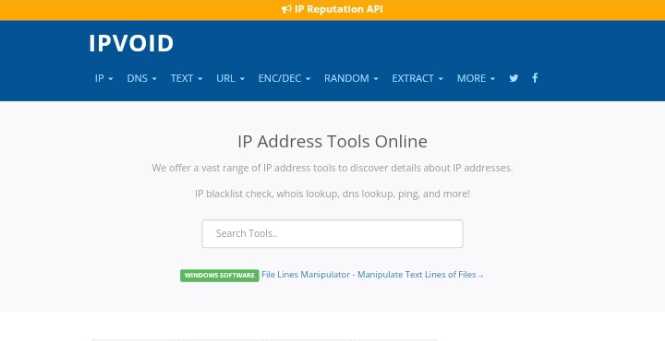DNS acts as a phone directory for the internet. By this, we mean that it is an internet-wide system that links website names to their respective IP addresses.
Whenever modifications or changes are made to Domain Name Server (DNS) records, your DNS IP will change and this could take a few hours or even days. Hence it becomes necessary to keep track of the current state of your DNS records during DNS propagation.
We’ll take a look at some of the best DNS propagation checkers in this post. Do yourself good and read this post to the end because it’ll be very insightful.
Table of Contents
WHAT IS DNS?
DNS (Domain Name System) is an essential component that makes accessing the internet easier. Although we are unaware of how much we depend on it, the internet could not run without it. Almost everything on the internet is a part of this system. It serves as a directory to match domain names and IP addresses to facilitate computer-to-computer communication. DNS is used to translate domain names into IP addresses.
The DNS system finds the matching address and connects you to the correct domain each time you type a domain name into your browser. You would have needed to enter the IP address of each website if there hadn’t been a DNS system.
Moreover, this system operates on a distributed, ranked structure. A tiny amount of the information pointing to a specific website or piece of hardware is stored in each DNS database. DNS enables an intuitive user experience by working together with the TCP/IP network protocol.
Billions of entries from electronic devices worldwide are processed by the DNS server. You could submit thousands of requests within a single internet browsing session. The fact that the DNS server answers requests in less than a second shows how busy it is.
WHAT IS DNS PROPAGATION?
Now that you know the fundamentals of DNS, you should be aware that any time a DNS is changed, there may be a slight delay in the output. “DNS Propagation” is the name given to this idea.
DNS propagation is the time it takes for modifications to a domain’s DNS to propagate to all servers on the planet. The completion of this operation typically takes between 24 and 72 hours.
Consequently, until the propagation is finished, certain users might only be able to access your website’s old hosting account. This duration is dependent on several variables such as TTL (Time To Live), geographic location, and ISPs (Internet Service Providers).
IS IT POSSIBLE TO ACCELERATE THE PROCESS OF DNS PROPAGATION?
If you want to update the DNS records and don’t want them to take a long time to spread over the internet, there is a way to speed up the propagation process.
The best method to accelerate DNS propagation is to change a record’s TTL value before updating the IP address on the record. When updating the NS record, allow the TTL adjustment to spread.
For instance, before changing the nameservers for your domain, set the TTL value of the A record to 300 seconds and give it some time. When DNS propagation is still ongoing, this technique aids in the domain’s resolution to the previous address from those places.
It is impossible to predict when the propagation of your website will be complete because it depends on various factors including the geographical region, ISP, TTL value, and domain name registries. You can use the list of DNS propagation checkers below to see if the DNS record information has spread to multiple nameservers located throughout the world.
HOW DOES DNS WORK?
DNS functions as a directory that associates domain names with IP addresses. The conversion process is referred to as “resolving”, and this process that takes place behind the scenes is invisible to the users.
The DNS server gets to work as soon as the domain name is entered into the search field. DNS Recursor, Root Name Server, TLD Name Server, and Authoritative Name Server are the four different types of DNS servers that are involved in the process.
four different types of DNS servers
1. The DNS Recursor
The ISP frequently offers the recursive DNS server, also known as the DNS recursor. It is in charge of answering any questions from users and providing the IP address in response. It organizes, transfers, and communicates information on behalf of the other servers, serving as a go-between. It connects the root server after first checking the cache to see if the desired IP address is there.
2. Root Name Server
When the DNS recursor is unable to locate the necessary data in the cache, it uses the root name server, also known as the root server. All requests are forwarded to an appropriate zone in the root zone, where the root server occupies the top position in the DNS hierarchy.
Thirteen root zone servers, run by various independent groups, may be found worldwide. The IP address of the TLD name server is what these 13 root zone servers return in response to the DNS recursor.
3. TLD Name Server
The TLD name server is the next entity the request must go through. Information for hostnames with popular extensions, like .gov, .edu, .com, etc., is stored on this server. The request is then routed by the TLD server to the IP address of the authoritative name server.
4. Authoritative Name Server
The request needs to be resolved in one more step, which is to use this server. The authoritative name servers contain data for special domains such as google.com. The hostname is resolved to the correct IP address and then sent back to the DNS recursor for caching. Ultimately, it is sent back to the user’s browser, allowing them to access the requested webpage.
This procedure takes only a few milliseconds to complete. Additionally, accessing a single website may necessitate using several resolutions if the host website contains a large number of links that lead to additional information or if there are redirects to other websites.
There is also a round-robin DNS approach that effectively balances load by having the authoritative name server carry the load. One domain name has multiple entries lined up, allowing the round-robin DNS to recognize the first entry and provide the correct IP address in response to a request.
The following entry in the line is sent when a new request comes in. A website with numerous redundant servers can use load balancing because of this unique DNS mechanism.
You might want to read: 5 Top Free Dark Web Browser
BEST DNS PROPAGATION CHECKER
Below is a list of some of the best DNS propagation checkers you need to try:
1. DNSMap

At the top of our list of the best DNS propagation checkers is DNSMap. It is one of the most popular internet resources for determining a website’s domain propagation status. It is really easy to use and fairly thorough. After choosing the record to check, type the name of the website into the input form provided and click “Check DNS propagation.”
This free DNS lookup tool checks for propagation around the globe by using a few global DNS servers from reputable worldwide operators like Google, Comodo, and Level3.
2. ViewDNS
ViewDNS is next on our list of the best DNS propagation checkers.
ViewDNS can assist you in verifying DNS propagation using up to 19 servers operating from various places across the globe and it also displays the IP address from which it gets data about your website.
It stands out because it provides 23 more helpful tools like Ping testing, reverse DNS lookup, MAC address lookup, URL/string decoding, ASN lookup, IP history checking, domain whois, DNS report, IP location finder, and much more.
It is simple to use; all you have to do is enter the domain name you wish to check to see if it has spread or not.
3. WhatsMyDNS
This is another amazing DNS propagation checker. WhatsMyDNS is a very straightforward tool to check for domain propagation. By leveraging DNS servers located at multiple worldwide checkpoints, it enables you to view details about any website. It supports DNS records like MX, CAA, TXT, and others.
The test results are processed and then presented on a globe map to make it easier to understand and enable you to explore individual request results in depth.
4. DNS Checker
Another excellent DNS propagation checker on our list is DNSChecker. It connects to numerous DNS servers across the globe and looks for unique NS entries. All you have to do is type in the domain name and select the DNS record to see if it has spread.
This website offers more tools, like DNS lookup, HTTP header checker, and webmaster tools and it currently supports 28 global checkpoints.
5. DNS Sniffer
Another DNS propagation checker program that may be used to verify domain DNS records, along with a variety of other data such as NS, NS CNAME, SOA, MX, A, AAAA, and WWW records, is DNS Sniffer.
You can use DNS Sniffer to access other helpful tools like Blacklist Lookup, MX Lookup, Email test, IP location finder, Whois, Ping test, Heartbleed, and many more.
You might also like: Top 5 Frequently Asked Questions in Cybersecurity Interview
6. IPVoid.com

DNS Propagation Checker is just one of the many helpful tools available at IPVoid.com. The DNS Checker itself is simple and to the point, and it does the job.
It includes other tools like IP Backlist Checker, WHOIS Lookup, Password Generator, HTTP/2 Test, SSL Certificate Check, Domain Reputation Check, and much more.
7. Ceipam
Ceipam is next on our list of best DNS propagation checkers. It is a free DNS checker tool provided by Camscape that allows you to verify DNS propagation with up to 17 servers from various locations, including A, MX, NS, SPF, and TXT records.
It also verifies DNS records with multiple name servers like Google, OpenDNS, RDS, Vodafone, UPC, NTT, Hostnet, and more. Several other services are also available on this website like Whois, Email test, HTTP headers, HTTP compression, and Page rank checker.
8. IntoDNS
IntoDNS is another popular DNS propagation checker. DNS record propagation is one of the many ways that IntoDNS inspects the setup and overall health of websites by providing mail server reports and domain name server information.
If a website’s health deteriorates, it displays Fix suggestions to address those problems and enhance the functionality of the site. With this tool, you may obtain the following information about any site: parent reports, NS, SOA, MX, and WWW records.
9. Site24x7

Next on our list of best DNS propagation checkers is Site24x7. With more than 50 locations worldwide, Site24x7 is a central information hub where you can verify whether your website’s DNS settings have been updated. It assists you in determining whether or not users and clients from around the world can access your website. It also displays the connect time, first-byte time, overall response time, and DNS resolve.
Numerous additional helpful services are available on this website like IP finder, site up/down, analyzing web pages, site pinging, SSL monitoring, heartbleed detection, IPv4 and IPv6 subnet calculation, and more.
10. Nexcess
Nexcess is another excellent DNS propagation checker that examines websites from up to 22 servers throughout the globe. It displays a wealth of additional data, including A, AAAA, NS, CNAME, MX, TXT, and SOA records for every website that is examined. It also displays the IP address of the servers that provided the findings.
You might like: 11 Best Website Traffic Tracking Tools (Free + Paid)
11. Preshweb
Preshweb is another straightforward and user-friendly DNS propagation checker for confirming and locating more helpful data on any website, like A, AAAA, NS, and TXT records. You can also use the number choices to check domain information.
It has numerous choices that you can use to test propagation, such as random, all-provided servers for a domain, or a specific server of your choice. You can examine the information on your sites by typing the IP address rather than the domain name.
12. DNS Unlimited

Next on our list of best DNS propagation checkers is DNS Unlimited. DNS Unlimited offers an amazing, user-friendly interface with a variety of useful features that can assist you in determining the number of servers and DNS zones that your website is hosted on throughout the globe.
Even though this program is still in development, it functioned flawlessly for the majority of zones as a DNS checker.
You can use this tool to find the MX, CNAME, AAAA, and A records for any website you’re interested in, as well as yours. It displays the website’s check results from IP-addressed public recursive and authoritative servers. Four of the five machines in their authoritative name server pool have IPv6 addresses.
13. DNSStuff
Wrapping up our list of best DNS propagation checkers is DNSStuff. DNSStuff offers a range of domain, IP, and networking tools, including email tests, WHOIS/IPWHOIS lookup, DNS report, TLD lookup, ISP cached DNS lookup, and reverse DNS lookup. Using this administering, monitoring, and analyzing tool, you can test your DNS server to ensure that there are no security breaches or vulnerabilities.
FAQs
How long does the propagation process take?
Although there is no precise answer, DNS normally propagates in a few hours but can take up to 72 hours. The internet service provider (ISP), the domain registry, and the TTL values of our DNS records are some of the variables that affect how long it takes for propagation to occur.
When does DNS propagation become important?
When you launch a new website or switch web hosts and modify the DNS Name Servers for your domain from the domain registrar, a DNS propagation check comes in handy. You can verify if the website is fully distributed worldwide or not by running a free DNS request against different IP addresses.
What should I consider for DNS propagation?
Every time you make a change to a DNS record, you should make sure that DNS propagation is implemented correctly. Because without verification, any modifications you make to your website or posts you publish could be stored in old hosting, and when new hosting takes over, your updated content will vanish from your website.
FINAL WORDS
Domain propagation happens every time you change a DNS record. Let’s say you recently transferred to a different web hosting company or changed the NS records for your domain from your domain registrar. In that scenario, it is highly advantageous to do a DNS propagation check.
The tools mentioned above can help ascertain whether the website has fully spread around the internet or not. We hope this post was helpful. You are welcome to share your comments below.
REFERENCE
- https://geekflare.com
- https://www.webtopic.com
- https://www.hostnamaste.com